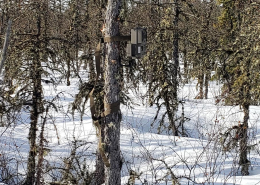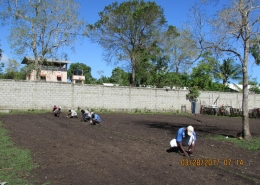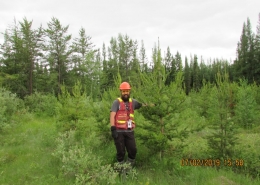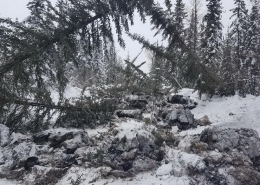Axe Lake, SK
SAGD
2013 - 2018
Introduction
Reclaimit began work with Axe Lake in 2013 with a roomful of file boxes to organize and the task of assessing the reclamation status of the entire asset. Since then, our task list has expanded, and Reclaimit consultants have worked steadily to improve the environmental status of the asset and release liabilities for our client.
Axe Lake is a former SAGD operation located in northwest Saskatchewan that operated from 2005-2010. Encompassing 730 km2 of boreal forest, the asset is comprised of more than 400 OSE well pads, an extensive network of unreclaimed access and various camp and facility sites. The site is remote and ground access has become increasingly unreliable as asset roads deteriorate.
The region is a mosaic of jack pine forest and peatlands and features numerous small waterbodies. The climate is sub-xeric, the area is subject to frequent forest fires and the majority of the soils are sandy, all of which contribute to unique reclamation challenges.
Tasks completed to date:
- Record organization and review
- Preliminary status assessment of more than 450 openings and 450 km of road network
- Land reclamation including bioengineering and revegetation
- Environmental monitoring and reporting for decommissioning activities
- Creation and negotiation of reclamation criteria for use on the asset
- Stain assessments on 66 locations
- 205 Phase I ESAs
- 2 Phase II ESAs
- 116 Saskatchewan Acknowledgment of Reclamation (AOR) approvals or Grandfathered equivalents
Preliminary Evaluation
Records Review
Reclaimit sorted, scanned and reviewed every record provided for the asset. Our team then constructed and began the population of an in-house database to track the development history of each disturbance as well as environmental status and reclamation objectives.
Status Assessments
All roads and openings on the asset were evaluated from 2013-2014. Apart from a few sites where landing was not possible, every opening was visited on the ground and Reclaimit assessors evaluated soil replacement and vegetation recovery and looked for environmental issues such as weeds, slumping and stains. Roads and water crossings were assessed for stability and any issues were noted for ongoing monitoring or restoration work.
Reclamation
Bioengineering and Erosion Control
Mitigation of any waterbody impacts began immediately. The region has very sandy soil and disturbances are highly subject to erosion. Reclaimit removed any ineffective silt fences and used bioengineering techniques to stabilize slopes where needed. Heavy equipment treatment combined with bioengineering and planting was used to treat larger-scale issues.

1. Significantly eroding slope treated with a combination of heavy equipment and manual techniques.
Revegetation
Collections for the establishment of a native seed inventory commenced during the preliminary status evaluations. Some of this seed was immediately sown in nursery to grow seedlings and tree-planting began in 2014, targeting openings that were recovering poorly. Since then, revegetation has effectively re-directed the restoration trajectory for hundreds of locations on the asset.

2. 2013 site conditions of an OSE and cement pit location identified internally as RCL 189. In 2014 this location was planted, and workers redistributed woody debris across the site to reduce erosion and improve microsites.

3. Condition of RCL 189 in 2018.
Reclaiming Roads and Restoring Hydrology
The methods used by the original operator to construct and maintain the asset access roads have rendered them slow to recover. Reclaimit has used heavy equipment, bioengineering and revegetation processes to improve natural recovery on many of these roads. Further, to effectively eliminate the need to de-build a more than 40 km of a main access road, Reclaimit consultants identified and spot-treated all hydrological impacts on the road and then used manual methods such as re-vegetation and woody debris to reclaim the remaining portions. These spot treatments used a small, heli-portable hoe and field labourers so complete reclamation of this main feature was achieved without the cost and complexity of a heavy equipment project.

4. Mini hoe at work removing a portion of the road impacting drainage through an ephemeral draw. Spot treatments like this prevented the need for a large-scale heavy equipment project to reclaim this road.
Decommissioning and Debris Clean Up
The majority of the Axe Lake structures and facilities have been decommissioned and removed since 2013. The Reclaimit consultancy has functioned as environmental monitor during these projects to ensure that activities did not negatively impact the environment and to identify and track any revealed areas of potential environmental concern (APECs) for future management.
Reclaimit teams have also cleaned up extensive debris left behind by the original operator and by ongoing recreational users of the site.

5. Removal of structures at one of the former camp openings on the asset.
Site Assessments
Stain Survey
The records review found evidence of numerous spills on the asset with an uncertain management history. Additionally, several APECs were identified by Reclaimit crews during assessment and reclamation projects. In 2017-2018 Reclaimit consultants conducted a stain survey on each historic and Reclaimit-identified site, conducting sampling where required to confirm or rule-out the presence of contamination and reporting subsequent results.
Reclamation Criteria
Axe Lake is in forested public land managed by the Saskatchewan Ministry of Environment (MOE). As such, the asset did not have applicable reclamation (DSA) criteria for vetting the status of sites for liability release. On behalf of our client, Reclaimit consultants devised and proposed a set of criteria to use, working with MOE to find benchmarks that were acceptable to all stakeholders.
These criteria have been successfully applied to attain Landowner Acknowledgment and subsequent AORs for 116 OSE location on the asset.
Remediation, reclamation, and regulatory sign off work continues.











